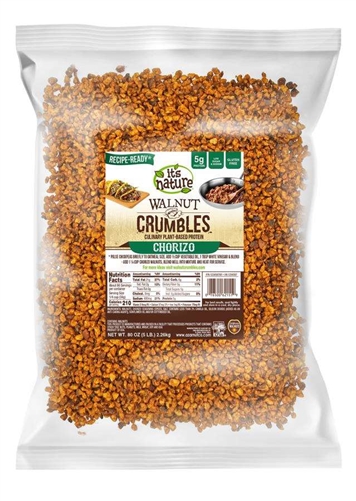
An Innovative Approach to a Traditional Ingredient
When it comes to marketing within food commodity boards, innovation is imperative to success. Being able to identify early trends and shifts in the marketplace can help unlock new opportunities for your food commodity’s product to flourish.
Here at EvansHardy+Young (EHY), we’ve had the privilege of helping several of our clients on their journey from an ingredient to the center of the plate. Here’s a peek into this evolution, as well as a few key takeaways you can apply to your business right away.
The Challenge: Expand Upon a Long-Standing Usage Occasion
At the start of this journey, California walnuts were an established ingredient in the food industry. However, walnuts were primarily used in baked goods or as a salad topper, both in homes and on menus. The goal was to expand their usage occasion – starting with menus within the foodservice industry.
Up to this point, operators didn’t realize the full potential and the versatility of walnuts beyond their traditional uses. Because of this, walnuts had become somewhat stagnant within the innovative foodservice pipeline. We needed to shake things up, and the emerging meat alternative trend was just the ticket.
A new strategy was put in place that positioned California walnuts as a clean, wholesome alternative for plant-forward menuing. This approach explored all meals throughout the day, investigated new opportunities to engage food pros and pursued nontraditional applications.
The Strategy: From an Idea to a Reality
From both a culinary and marketing perspective, the investment in trend research and culinary R&D was a top priority.
Before anything was executed, it was essential to understand the target consumer’s perspective on walnuts and plant-based meat alternatives. California Walnuts was encouraged to conduct an IQ survey that uncovered valuable insights and helped our agency set the right tone. For example, the research found that more than 80% of Americans were open to eating and making meatless dishes, particularly if they had a similar taste or texture to meat-centric dishes. Also, participants specifically chose walnuts for their texture (70%), flavor (65%) and nutrients (62%).
To apply this insight, a strategic outreach campaign was launched. Geared toward food professionals, ReThink Walnuts focused on using walnuts as a meat alternative in various applications. Through its plant-forward lens, the campaign celebrated the powerful whole-food goodness of California walnuts. It also touted the versatility of walnuts and their many benefits, including being the only tree nut to offer an excellent source of plant-based omega-3.
The Results: From Reality to a New, Innovative Product Offering
Recipe development was (and continues to be) a huge part of this program. California Walnuts has developed unique plant-forward meat alternative recipes like Walnut “Chorizo” for tacos, Walnut Omega Burger and Walnut Sausage Crumble for pastas, pizzas and chilis. Today, their website drives increased traffic each month to new, trend-right recipes that are expanding the perception of walnuts.

Adding to the excitement of the R&D program, Azar Nuts dba Mount Franklin Foods developed It’s Nature Walnut Crumbles after attending the exclusive foodservice chef summit, Camp Walnut. Inspired by the plant-based menu ideas presented at the event, Azar decided to launch a product based on the California Walnut “Chorizo” Crumble recipe.
Not only does this meat alternative taste delicious but it also gives foodservice operators an opportunity to elevate plant-based menu options made with protein from California walnuts. Culinary kits including chopped and seasoned walnuts are available in five-pound bags in two amazing flavors: Chorizo and Italian.
In addition to the new walnut crumble product, we’ve also learned more operators are using the California Walnut recipes in scratch format. Velvet Taco and Marriott are two who have done so over the past year. These initiatives have created a solid foundation for California walnuts becoming one of the go-to plant-based ingredients of choice.

How-To: Inspiring New Usage Occasions for Your Food Brand
To bridge the momentum created in foodservice to broader appeal and awareness, we had to take a more integrated marketing approach. Here are seven activations that you can use to help position your ingredient/product as a meat alternative.
- Position your brand as an industry thought leader by launching signature virtual events, and in-person events once it’s safe to do so. These events help stimulate recipe development and educate food professionals about the wide variety of recipe possibilities. For California Walnuts, events like Camp Walnut and Walnuts@Work Live virtual event have been instrumental to their success.
- Curate a recipe collection and highlight these recipes across print and digital ads to encourage food professionals to utilize your ingredient/product for formulations and menuing. California Walnuts has a robust library of recipes that are now “shoppable,” connecting their efforts with the trend in online grocery for consumers.
- Target food manufacturers and foodservice operators with engaging educational videos to showcase the versatility of the ingredient/product in creating meat alternatives.
- Craft strategic and relevant pitches to the media to foster inclusion for your ingredient/product within foodservice publications.
- Create social media content supporting plant-forward eating by sharing recipe inspiration through storytelling, trends and videos to stoke usage. Take a look at @cawalnuts for inspiration.
- Plan tasting opportunities and hands-on ideation sessions to serve as a culinary springboard for chefs and operators. There are even creative virtual ways to encourage sampling, like putting together an operator recipe ingredient kit. Then have them cook along during a live Zoom call with your chef consultants to bring new menu ideas to the table.
- Formulate integrated partnerships with top foodservice operators. These partnerships can better ensure innovation is baked into your strategy. For example, California Walnuts worked with the Restaurant Associates marketing and culinary team to bring some of their top plant-forward recipes to life in RA cafés during a unique LTO lunch program.
The Future Is Ripe With Opportunity
The rise of meat alternatives has been driven by the realization that plant-based meats don’t have to be a super niche product just for vegans or vegetarians, who only make up about 3% of the U.S. population. Many meat-eating Americans are up for trying plant-based products as long as they’re tasty, reasonably priced and nutritious. Plant-forward eating is at the top of every trend report and will continue to be as consumers’ eating patterns evolve.
Consumers are identifying as vegan, vegetarian, flexitarian, Mediterranean, plant-based and plant-forward – just to name a few. There are now more ways than ever for your consumer to define their eating preferences. As food marketers, being able to spot these trends early and work with the right foodservice partners to innovate can unlock a huge opportunity to expand your usage occasions.
Especially in the coming year as new habits form, are your consumers showing you any early signs of new behavior? Start investigating now – it’s never too late to innovate.




